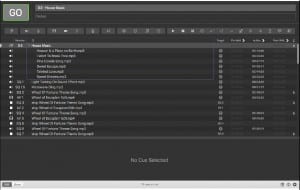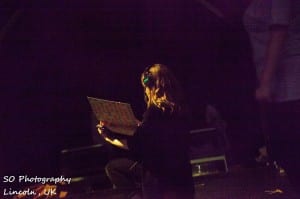Our entire company went into our technical rehearsal day with all the enthusiasm and energy we could have. After four days of intensive, long rehearsals perfecting the show and creating our props and set, we felt ready to get into the space and see our show fully take shape with the lighting, sound and set all in place.
To ensure this day ran as smoothly as possible, I created a schedule (that can be found in our Technical Documents page) that I sent to all members of the company and the LPAC technical team the day before our technical rehearsal so that everyone involved was aware of the plan of action. I also decided to create the Qlab file in advance of the Technical Rehearsal to save time. This meant that, after we built the set, all that needed to be done to the sound was setting levels which then freed up our Technical Designer, Ben, to programme the lights.
Figure 1 – Screenshot of the first 12 cues in the Qlab file (Workman, 2017)
We faced a few obstacles throughout the day, including rescheduling, as it took longer than anticipated to build our set so a cue to cue run was not able to happen. We were also confronted with an issue surrounding the AV which was originally going to be played across multiple TV screens scattered across the stage. However, after a conversation with the technical team on the day it turned out that this was no longer possible. They gave a few suggestions on how to overcome this, which lead me to make the executive decision to have three white bed sheets rolled up and tied to the platform at the back of the stage, which were released by the cast during the final scene to facilitate the projections that made up the end of our show. I made this decision because I believed that the aesthetic of the bed sheets tied with string would contribute to the overall mise en scène of our production.
Figure 2 – Picture of Interviews Projected onto Sheets (Odonnell, 2017)
Show day ran smoothly thanks to the updated day schedule I created after the technical rehearsal. I ended up both calling the show and operating the lights, neither of which I have done before. I feel as though I did a good job at both as the show ran perfectly on time with no technical faults or missed cues. I felt so privileged to be able to sit and watch all our hard work over the last few months come together on the LPAC stage that evening. Sitting in the tech box with the cans over my head confirmed for me that a career in technical theatre and stage management is definitely what I want to pursue.
Figure 3 – Picture of Stage Manager with Cans and Book (Odonnell, 2017)
After reflecting on our own work and process and being introduced to the notion of DIY theatre, I undertook individual research in which I found a book by Sarah Jane Bailes entitled Performance Theatre and the Poetics of Failure. In this book, Bailes states that ‘The proliferation of independent do-it-yourself/home-made artistic production […] reflects the intensity of urban living and the countless subversive and often invisible ways individuals and communities are able to undermine the political, cultural, and social order propagated by hegemonic ideology (Bailes, 2011). This quote sums up the reason our show utilized DIY theatre without necessarily realising it. We wanted to create a show that spoke to the underdog, the little people in society that get overshadowed in a world ruled by hegemony.
I also found an article written by Lyn Gardener for The Guardian about DIY theatre.
DIY is often associated with an aesthetic that celebrates the imperfect and the make-do-and-mend mentality. But that’s not to mean that it is inexpertly crafted or just throwing a show together and plonking it down in front of an audience and hoping for the best. In times of financial hardship or when buildings and programmers act more like gatekeepers than midwives, DIY can be born of necessity.
(Gardener, 2014)
Following this, I realised DIY theatre correlated with the overall aesthetic of our piece, which I believe, if we were to produce the show again, we could embrace further. Gardener mentions Little Bulb theatre company in this article whom we as a company were lucky enough to see performing their most recent production Wail on 17th March 2017, which, in hindsight, set us on the path of DIY theatre before we fully realised what we were creating, as we enjoyed the make shift aspects of their production and wished to replicate this.
Trailer for Wail – (Little Bulb Theatre, 2017)
Following on from this, if we were to continue as a company with this production or any other shows we may create, to ensure viability to tour around the country where necessary, we would definitely keep this idea of DIY theatre at the forefront of our aesthetic.
Works Cited
Bailes, S. J. (2011) Performance Theatre and The Poetics of Failure. Oxon: Routledge.
Gardener, L. (2014) DIY theatre (because nobody else will). The Guardian, 23 October. Available from https://www.theguardian.com/stage/theatreblog/2014/oct/23/diy-theatre-little-bulb-chris-goode [accessed 26 May 2017]
Little Bulb Theatre (2017) WAIL – UK TOUR 2017 [onilne video]. Available from https://www.youtube.com/watch?v=8U7zBYhNS3k [accessed 26 May 2017]
Figures
Figure 1 – Workman, L. (2017) Screenshot of the first 12 cues in the Qlab file. Lincoln.
Figure 2 – Odonnell, S. (2017) Picture of Interviews Projected onto Sheets. Lincoln.
Figure 3 – Odonnell, S. (2017) Picture of Stage Manager with Cans and Book. Lincoln.



Leave a comment